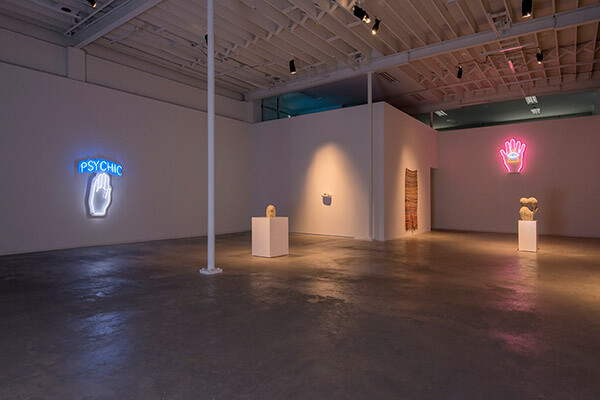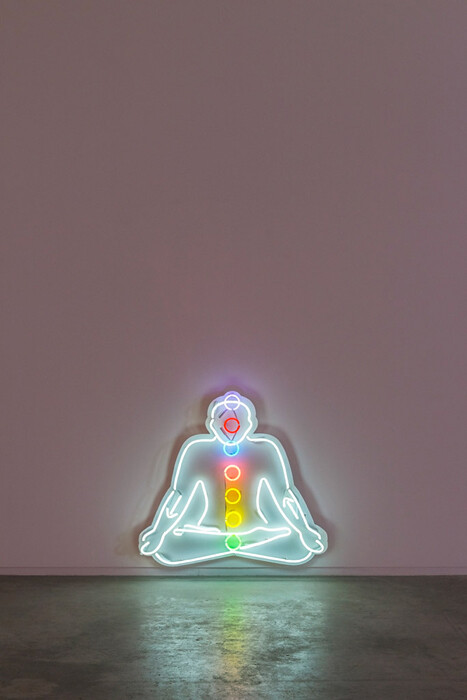Shopfront esoterica and modernist sculpture rub shoulders in “Tell Her Nothing She Tells All,” Myfanwy MacLeod’s current exhibition at Catriona Jeffries, Vancouver. Borrowing its title from a slogan common to psychic shops, the show continues MacLeod’s interest in using pop and vernacular languages to, as she puts it, “speak to more profound things.”1
MacLeod is better spoken than most; over the past 20 years, she has quoted everything from muscle car to moonshine still, Playboy pinup to barn hex. At their best, these references do more than just level the cultural field. Tiny Kingdom (2001), for example, replicates the outhouse from the 1968 film Chitty Chitty Bang Bang. Reflecting on the work, MacLeod proposes “the outhouse as a symbol of Canadian national identity”—an undignified marker of the country’s colonial past. For a recent public art commission, she fabricated two sixteen-foot-tall sparrows, which flank a plaza that served as the 2010 Vancouver Olympic Village (The Birds, 2010). MacLeod has described choosing sparrows not only for their insufferable cuteness, or their Hitchcockian portent, but also for being non-natives of North America that grew into a dominant species. As these works demonstrate, the artist excels at turning known quantities into platforms for social commentary.
“Tell Her Nothing She Tells All” focuses on the objects and practices usually lumped under the banner of “New Age.” On three walls of the gallery are neon facsimiles of street advertisements for psychics and healers. The most playful one, Seated Figure (2015), shows a man meditating just above the gallery floor, his chakras stacked in the wrong order. Hanging high on the back wall is the Eye of Providence, enclosed by a pink neon hand that irradiates the nearby works (Five, 2015). Displaced from their intended function, these neons strike an ambivalent pose in the gallery setting. In a sense, they’ve traded up: transforming from commercial signs into commercial objects, from advertising spiritual enterprises to becoming endowed, as artworks, with their own significance. Their displacement, in other words, makes an analogy between the consumption of art and pop mysticism that is both amusing and unpleasant to stomach.
Continuing in the vein of the facsimile, MacLeod has recycled foam yoga blocks to make replicas of Isamu Noguchi and Jean Arp sculptures, respectively titled after their sources (Woman and Crown of Buds, 2015). Arp himself was no stranger to waste material, often using discarded fabric and paper for his artworks; MacLeod, for her part, gives the yoga foam a chipboard-like quality, which interferes with the simplicity of her reference forms, bringing a hectic visuality to the serene volumes. As with her 2014 survey at the Vancouver Art Gallery, “Or There and Back Again,” peppered with the works of male artists from the collection, MacLeod’s formal transformations reappraise the canon on both aesthetic and gendered terms.
MacLeod’s exhibition is a sparse affair, with a handful of smaller objects that solicit intimate viewing. One welcome exception is Churinga (2015), a LightJet print of an opal, which the artist has set in a comically large gold frame. Culturally, churingas are stone or wooden objects considered sacred by Australian aboriginal tribes, often for providing a bridge to totemic ancestors. As such, they span lived and mythological time. By photographically enlarging an opal, MacLeod has amplified the churinga’s supposed powers. The resulting print, roughly the size of a full-length mirror, captures the many contradictions of the “New Age” seeker (the implicit protagonist of this show). In its shimmering rainbows, the opal reflects not who we are, but the sublime being we imagine ourselves to be—a being, we are told, who is attainable through the purchase of magical goods, no matter their original context and use.
Deborah Campbell, “Pop Pastoral,” Vancouver Review, 2006. Cited in Cassandra Getty, “Then As It Was, Then Again It Shall Be: An Introduction,” in Myfanwy MacLeod, Or There and Back Again (London: Black Dog Publishing, 2014), 9.










